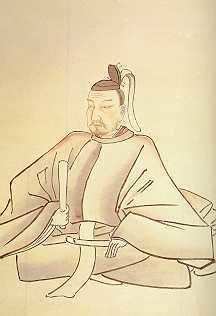Tokugawa Ieharu (徳川家治) (June 20, 1737 – September 17, 1786) was the tenth shogun of the Tokugawa shogunate of Japan, who held office from 1760 to 1786.
His childhood name was Takechiyo (竹千代).
Ieharu died in 1786 and given the Buddhist name Shunmyoin and buried at Kan'ei-ji.
Father: Tokugawa IeshigeMother: Oko no Kata (?-1728) later Shinshin'inAdopted Mother: Okume no Kata later Kakuju-in (1697-1777)Wife: Iso no Miya Tomoko (1738-1771)Concubines:Umaki no KataOmaki no Kata (1737-1791) later RenkoinOshina no Kata (d.1778) later Yoren-inChild:Chiyohime (1756-1757) by TomokoManjuhime (1761-1773) (born by Tomoko but after she died adopted by Ieharu's concubine, Omaki no Kata)Tokugawa Takechiyo later Tokugawa Iemoto (1762–1779) born by Omaki no KataTokugawa Teijiro (1762-1763) born by Oshina no KataAdopted:Tokugawa IenariTanehime (1765-1794), daughter of Tokugawa Munetake and married Tokugawa Harutomi of Kishu DomainTenmei gannen (天明元年) or Tenmei 1 (1781): The new era name of Tenmei (meaning "Dawn") was created to mark the enthronement of Emperor Emperor Kōkaku. The previous era ended and the new one commenced in An'ei 11, on the 2nd day of the 4th month. According to Nihon Ōdai Ichiran, Ieharu was appointed Udaijin (Minister of the Right) of the Emperor's Kugyō, which was quite rare and considered a great favour.Tenmei 2 (1782): Great Tenmei Famine begins.Tenmei 2 (1782): An analysis of silver currency in China and Japan "Sin sen sen pou (Sin tchuan phou)" was presented to the emperor by Kutsuki Masatsuna (1750–1802), also known as Kutsuki Oki-no kami Minamoto-no Masatsuna, hereditary daimyō of Oki and Ōmi with holdings in Tanba and Fukuchiyama -- related note at Tenmei 7 below.Tenmei 3 (1783): Mount Asama (浅間山, Asama-yama) erupted in Shinano, one of the old provinces of Japan. Japanologist Isaac Titsingh's published account of the Asama-yama eruption was the first of its kind in the West (1820). The volcano's devastation makes the Great Tenmei Famine even worse.Tenmei 4 (1784): Country-wide celebrations in honor of Kūkai (also known as Kōbō-Daishi, founder of Shingon Buddhism) who died 950 years earlier.Tenmei 4 (1784): The son of the Shogun's chief counselor was assassinated inside Edo Castle. The comparatively young wakadoshiyori, Tanuma Yamashiro-no-kami Okitomo, was the son of the senior wakadoshiyori Tanuma Tonomo-no-kami Okitsugu. The younger Tanuma was killed in front of his father as both were returning to their norimono after a meeting of the Counselors of State had broken up. The involvement of senior figures in the bakufu was suspected; however, none but the lone assassin himself was punished. The result was that Tanuma-initiated, liberalizing reforms within the bakufu and relaxation the strictures of sakoku were blocked.Tenmei 6, on the 8th day of the 9th month (September 17, 1786): Death of Tokugawa Ieharu. He is buried in Edo.Tenmei 7 (1787): Kutsuki Masatsuna published Seiyō senpu (Notes on Western Coinage), with plates showing European and colonial currency -- related note at Tenmei 2 above. -- see online image of 2 adjacent pages from library collection of Kyoto University of Foreign Studies and Kyoto Junior College of Foreign LanguagesThe years in which Ieharu was shogun are more specifically identified by more than one era name or nengō.
Hōreki (1751–1764)Meiwa (1764–1772)An'ei (1772–1781)Tenmei (1781–1789) 
